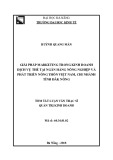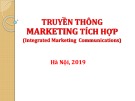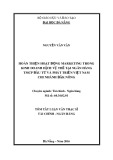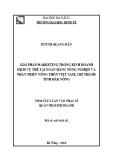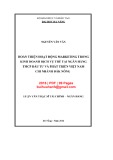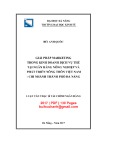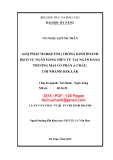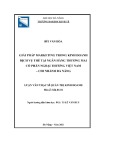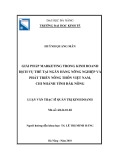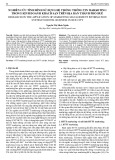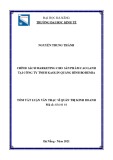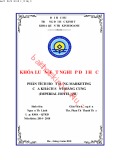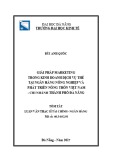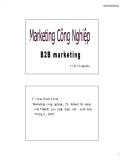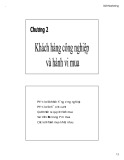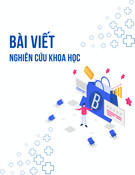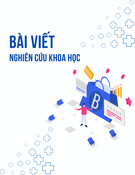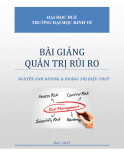1/2/2017
Chapter 2 Understanding Business Market and Environment
www.dinhtienminh.net
DINH Tien Minh (Ph.D.) University of Economics HCMC
Understand types of business customers and and
industrial
goods
of
classification services.
Know purchasing orientations and practices
of business customers.
Understand
environmental
analysis
in
business marketing.
Objectives
2
Content
2.1 Types of business customers (B.C)
2.3 Purchasing orientations of B.C
2.2 Classification of industrial product
2.4 Types of buying situations
2.6 Questions and Homework
2.5 Environmental analysis of B.M
3
1
1/2/2017
Krishna K Havaldar (2010), Business Marketing, McGraw Hill, 3rd edition, p16.
2.1. Types of Business Customers
4
Krishna K Havaldar (2010), Business Marketing, McGraw Hill, 3rd edition, p16.
2.1. Types of Business Customers (cont’)
5
2.2. Classification of Industrial Product
Krishna K Havaldar (2010), Business Marketing, McGraw Hill, 3rd edition, p18.
6
2
1/2/2017
Krishna K Havaldar (2010), Business Marketing, McGraw Hill, 3rd edition, p18.
2.2. Classification of Industrial Product
10
Krishna K Havaldar (2010), Business Marketing, McGraw Hill, 3rd edition, p18.
2.2. Classification of Industrial Product
12
Business buyers choose one of
the three
2.3. Business Customer’s Purchasing orientation
purchasing orientations: Buying Procurement Supply Chain Management (SCM)*
(*)James C. Anderson & James A. Narus, Business Market Management, Pearson Education, Inc., 2004, 91-105.
15 15
3
1/2/2017
2.3. Business Customer’s Purchasing orientation (cont’)
Purchasing Orientation of Industrial Customers
Krishna K Havaldar (2010), Business Marketing, McGraw Hill, 3rd edition, p21.
16 16
2.3. Business Customer’s Purchasing orientation (cont’)
1. Buying orientation: This purchasing firm has a narrow and short-term focus. The buyers follow the practices as below:
• Always select the lowest price supplier. • Quality and availability are the factors considered as
qualifiers.
• The qualified suppliers are invited to negociate. • The negociation style used is WIN & LOSE.
Lowest Price:
17 17
2.3. Business Customer’s Purchasing orientation (cont’)
1. Buying orientation:
Gain Power over the suppliers by using
• Commodification: Buyers tell
that
the product
is a
commodity and price is the only thing to be negotiated.
• Multisourcing: Buyers ask quotations from several suppliers who compete to get more share of purchase.
commodification & multisourcing:
18 18
4
1/2/2017
2.3. Business Customer’s Purchasing orientation (cont’)
1. Buying orientation:
• Follow the standard purchase procedure of company.
• Work with the suppliers who proved their performance.
The tactics used for avoiding risk are:
19 19
improvements
quality
and
2.3. Business Customer’s Purchasing orientation (cont’)
2. Procurement orientation: This purchasing firm has a long-term focus. The buyers seek both cost reductions.
Collaborative relationship with major suppliers:
• Both Supplier and Buyer must trust one another. • Have inter-firm team who implements J.I.T and quality
assurance.
• The integrative negociation includes
focusing on
common interests and goals.
20 20
2.3. Business Customer’s Purchasing orientation (cont’)
2. Procurement orientation:
Working closely with other functional areas: • Clarify the specifications of the products or services. • Ensure the quality of purchased goods. • Keep timely availability of products or services. • Work closely with manufaturing group on Materials
Requirement Planning (MRP).
21 21
5
1/2/2017
2.3. Business Customer’s Purchasing orientation (cont’)
3. Supply Chain Management Orientation:
It concludes coordinations and integration of many functional teams within the company and with other organisations in the whole value chain.
The company focus on how to improve the whole
value chain from raw materials to end-users.
22 22
2.3. Business Customer’s Purchasing orientation (cont’)
3. Supply Chain Management Orientation:
• Study to understand the requirements of end-users.
• Direct the entire supply chain to deliver superior value
to them.
I. Deliver Value to End-Users:
23 23
2.3. Business Customer’s Purchasing orientation (cont’)
3. Supply Chain Management Orientation:
II. Outsource Non-core Activities:
• Identify the core competence of the company.
• Group its products and services into strategic and
nonstrategic systems.
• Outsource
those
systems
that has become non-
competitive.
24 24
6
1/2/2017
2.3. Business Customer’s Purchasing orientation (cont’)
3. Supply Chain Management Orientation:
III. Support collaborative relationship with
major Suppliers:
• Work with major suppliers in partnering relationship trust and
require cooperation, communication,
that commitment.
• The objective is to lower total cost, increase value in
order to achieve mutual benefits.
25 25
2.4. Purchasing Practices
1. Purchasing in Commercial Enterprises
and the size of the
The purchasing practices depend on the nature of business commercial entreprise as well as the volume, variety, and technical complexity of the products purchased.
The purchase decisions involve persons from production, material, as such departments finance, engineering...
26 26
2.4. Purchasing Practices (con’t)
Activity
Step 1.
2.
Responsibility User department (e.g. Production, Marketing,) Purchase department
the material
3.
User department initiates the process by issuing purchase requisition (P.R) to the purchase (materials) department. Check if the material required is in stock. If is issued to the user yes, department and the P.R. is filed, indicating action taken. If the material (required as per P.R.) is not in stock, then identify potential suppliers, get quotations, negotiate, select supplier(s). and issue purchase order (P.O.)
Purchase department (for negotiation and selection, technical & departments finance are also involved).
4.
The supplier/ vendor acknowledges the P.O. Supplier (or vendor)
27 27
7
1/2/2017
2.4. Purchasing Practices (con’t)
Step
Activity
Responsibility
5.
6.
Purchase department Supplier
transporter
name)
to
7.
Stores
the material
checks
Follow-up with the supplier (if required) on delivery The supplier des-patches the material and informs the dispatch details (such as invoice and truck receipt number and date, invoice purchase value, department On receipt of material, stores (or receiving department) against delivery and P.O. and issues material receipt report (M.R.R.)
28 28
2.4. Purchasing Practices (con’t)
Step
Activity
Responsibility
8.
(or
control
9.
Quality or inspection department Purchase department
10.
Quality inspection) department inspects the material and issues inspection report (I.R.) Purchase department issues supplier invoice along with M.R.R and I.R. to accounts department for payment and closes the order if it is executed fully Accounts department checks all the above documents with P.O. and issues payments to supplier
Accounts (or finance) department
Krishna K Havaldar (2010), Business Marketing, McGraw Hill, 3rd edition, p23.
29 29
2.4. Purchasing Practices (con’t)
1. Purchasing in Commercial Enterprises
The major tasks in purchasing process are:
• Identifying potential suppliers. • Negotiating and selecting suppliers. •
Ensuring right quality and quantity of material at the right time.
• A long-business relationship with the suppliers.
30 30
8
1/2/2017
2.4. Purchasing Practices (con’t)
2. Purchasing in Governement Units
• Closed/ Sealed Bidding. • Open Bidding/ Open Tender. • Reverse Bidding (Buyers set the highest possible
bidding price that they accept).
• Government contracts (Fixed-price contract, Cost-
reimbursement contract).
The suppliers must fulfill a set of standard terms and conditions issued by procurement Dept. There are several methods of purchasing:
31 31
2.4. Purchasing Practices (con’t)
Global Tender of India Government
Krishna K Havaldar (2010), Business Marketing, McGraw Hill, 3rd edition, p25.
32 32
2.4. Purchasing Practices (con’t)
3. Institutional Purchasing
Institutional buyers are either the government or the private organisations. Thus, they follow the government purchase procedures or commercial enterprise’s one.
33 33
9
1/2/2017
2.5. Environmental analysis in B.M
Types of Environment
Krishna K Havaldar (2010), Business Marketing, McGraw Hill, 3rd edition, p28.
34 34
Organizational Factors
2.5. Environmental analysis in B.M (con’t)
delegate it throughout the units.
Successful marketers must understand their customers’ structures, policies, and purchasing systems. Some firms have centralized procurement, others
Many companies use multiple sourcing to avoid depending too heavily on a sole supplier.
35 35
Environmental Factors
2.5. Environmental analysis in B.M (con’t)
Economic, political, regulatory, competitive, and technological considerations influence business buying decisions. Example: Natural disasters, such as Katrina; Rising fuel prices.
36 36
10
1/2/2017
Example of Competitors
Avoid Head-On Competition!
Monopoly
Oligopoly
Monopoly
Oligopoly
Monopolistic Monopolistic Competition Competition
Pure Competition
Know the Market Situation!
37
Example of Competitors
High Medium Low
Quality
Medium
High 2 3 1
A
5
4
e c i r P
Low 7 8 6
Based on your industry/ product chosen, what are your cells and why?
38
2.6. Questions and Homework
1. Explain with an example an OEM (Original Equipment Manufacturer) customer, ‘how an OEM customer is different than a user customer?’
2. What are the major differences between supply buying orientation and chain management orientation?
3. Why companies carry out environment analysis? Mention major micro and macro environment factors or forces.
39
11
1/2/2017
2.6. Questions and Homework (Con’t)
1. Can a customer be classified as an OEM as well as user customer? Explain with an example.
2. A major electrical equipment (like transformers and switch-gear) manufacturer try to have collaborative relationships with high business potential government organizations like State Electricity Boards. What are the possibility of success of this strategy? Explain the reasons.

